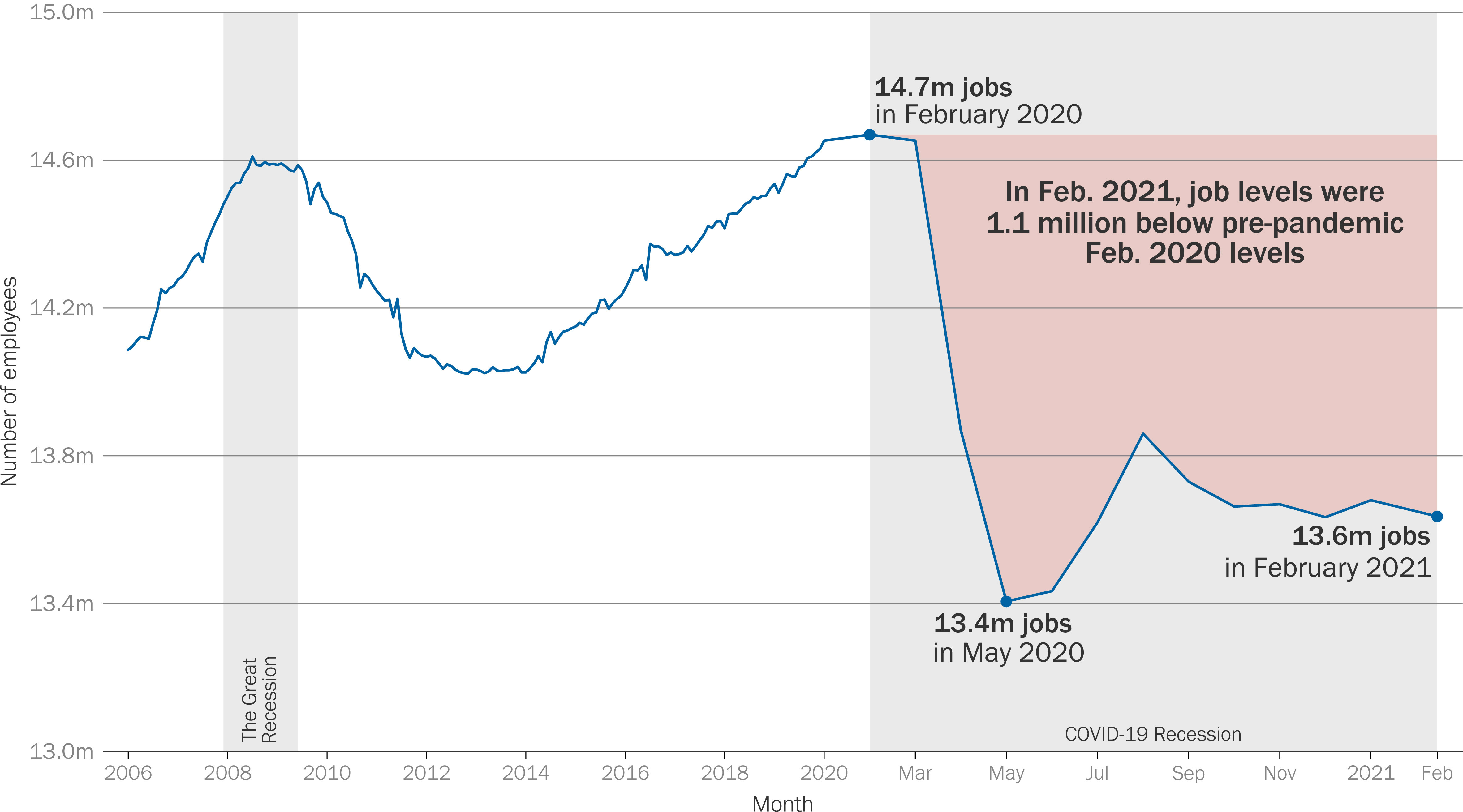Key Takeaways
|
|
The Unemployment Rate Decreased Marginally by 0.1 Percentage Points,
Over 10 Million Americans Remain Unemployed
Change in the National Unemployment Rate, Jan. 2020 – Feb. 2021
The February Employment Situation report from the Bureau of Labor Statistics (BLS), released on March 5, revealed little to no change in labor market indicators. Overall, nonfarm payrolls reportedly increased by 379,000 jobs, but the unemployment rate only decreased by 0.1 percentage point and the number of jobs in the economy is still 9.5 million (6.2 percent) lower than pre-pandemic levels.
Despite the small increase in the number of jobs, the number of persons unemployed remains at nearly 10 million, with little change from the preceding month. Further, this indicator is still about double the level it was 12 months ago in February 2020.
Other important labor market indicators rang stagnant in February, demonstrating a stalling recovery and increased need for additional aid for recovery.
The labor force participation rate, a measure of the number of persons employed or seeking work, experienced no change and still remains 1.9 percentage points lower than pre-pandemic levels. No changes in the labor force participation rate indicate that workers’ uncertainty in their ability to find a job has not reduced in recent months..
The number of persons who are not in the labor force but want a job also had little change (-227,000), totaling about 6.9 million persons. Individuals in this category do not count towards the unemployment rate statistics since they were not actively looking for work in the past month. Under normal circumstances, however, they would likely be a member of the labor force.
Finally, the number of persons employed part time for economic reasons, but who would prefer full time employment, experienced a slight decrease (-88,000) in February. Now totaling over 6.1 million persons, these underemployed individuals have had their hours reduced or were unable to find full-time jobs due to the labor market conditions.
Local Government Employment Decrease by 44 Thousand Jobs in February
Local Government Employment Levels, 2006 – Feb. 2021

Nearly a year into the pandemic, local government employment still remains over 1 million jobs short of its level last February 2020. The sector lost another 44,000 jobs this past month, thus eclipsing its small gains from January 2021 with losses of 37,000 education jobs, as well as 8,000 non-education jobs. For five consecutive months now, local government employment has changed very little, indicating that local governments are by no means on the road to recovery, but remain stagnant and struggling. With over 10 million Americans still unemployed, one in ten jobs yet to be recovered is a local government job.
Minimal Job Gains in February, Spread Across Multiple Sectors
Change in Employment by Industry, Jan. 2021 – Feb. 2021
Most of the job gains in February were concentrated in the leisure and hospitality sector. Other, smaller job gains occurred in temporary help services, health care and social assistance, retail trade and manufacturing. Industries such as construction and mining cut jobs over the month.
- In February, health care and social assistance increased by 46,000 jobs, though the industry remains 908,800 jobs lower from a year ago. Most of the job gains in this industry occurred in ambulatory health care services (+29,000) partially offsetting losses that occurred in nursing care facilities (-12,000). Health care employment levels changed little, adding 20,000 jobs over the month.
- Employment levels in the retail trade industry increased by 41,000 jobs in February. Job gains occurred in general merchandise stores (+14,000), health and personal care stores (+12,000) and food and beverage stores (+10,000). These job gains partially offset losses in in clothing and clothing accessories stores (-20,000). Employment in retail trade is down by 362,600 from a year ago, though the industry has recovered 2 million of the jobs lost in March and April.
- The manufacturing industry added 21,000 jobs in February. Employment in durable goods increased by 17,000 in February, while nondurable goods saw growth of 4,000 jobs. The industry’s employment levels are down by 561,000 jobs from a year ago despite a gain of 803,000 jobs since April.
- Despite job gains over the past 10 months, the professional and business services industry is down by 175,000 jobs from a year ago. Notable job gains in the industry occurred in temporary help services (+53,000) over the month.
- The leisure and hospitality sector increased by 355,000 jobs in February, accounting for most of the job gains this past month. Most of the industry’s gains occurred in food services and drinking places (+286,000). Accommodation (+36,000) and amusements, gambling, and recreation (+33,000) each added jobs over the month. The industry is still down by 3.5 million jobs since February 2020.
- Other major industries that experienced job losses in February include construction (-61,000) and mining (-8,000), while wholesale trade, transportation and warehousing, information, financial activities and other services changed little over the month.
Long-Term Unemployment Increases to More Than Seven-Year High
Change in Number of Long-Term Unemployed Persons, Jan. 2020 – Feb. 2021
Long-term unemployment, a particularly important indicator of economic health and for measuring the strain of the pandemic on local government resources, experienced a slight increase in February (145,000). This indicator, now at a more than seven-year high, accounts for over 40 percent of all unemployed individuals. As long-term unemployment continues to increase, the strain on county resources furthers.
As with last month, long-term unemployment is over 3 million persons higher than it was 12 months previous, or nearly 2.5 times higher. Continued high levels of long-term unemployment could impact the broader economy by hindering labor force recovery, and further increases will only increase the strain on local governments.
Rapid Economic Stimulus is Needed to Aid Labor Market Recovery
The need for additional aid is overwhelming. Moody’s Analytics predicts the passage of the $1.9 trillion American Recovery Act package could boost the recovery, allowing the economy to return to full employment by early 2022. If the package is passed, Moody’s also predicts GDP could grow by over 6 percent by the end of the year.
Pandemic-related costs have increased significantly for almost all local governments, outpacing revenues across the nation. National reports on local government revenue are limited and capture only a slice of county government revenues (for example, only 38 percent of county revenues are generated from taxes) and only available through Sept. 30, 2020. A COVID-19 coalition survey captured more recent data illustrating the local financial situation. In the Dec. 2020 survey, most counties reported negative financial impacts of COVID-19.
Many state and local governments have cut budgets and are on track to continue to cut budgets. These cuts are concerning because reduced state and local government spending in the wake of the Great Recession inhibited economic growth for nearly six years (22 out of the 26 quarters between 2008 and mid-2014), resulting in a $650 billion lower GDP by the end of 2015 (3.5 percent lower). Not only will county austerity measures reduce economic growth, but they will also impact local government services for years to come. When a local government service is cut, that service often remains cut, hurting residents and communities in the long run.
Local governments are uniquely positioned to drive economic recovery, organize vaccine distribution and execute the local public health response. Every dollar of local government aid is at least a dollar increase in GDP growth. Without this additional aid, our nation’s economy will suffer. Following the Great Recession, it took 133 months (11 years and 2 months) for local government employment to return to pre-recession levels, inhibiting the capacity of counties – one of the nation’s largest employers – to serve local communities. Local government spending, bolstered by federal aid, will drive COVID-19 economic recovery, restore one of the nation’s largest workforces and prepare communities for future growth through vital infrastructure, health, safety and resiliency investments.
Read the full February Employment Situation from the Bureau of Labor Statistics here.



